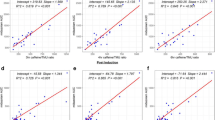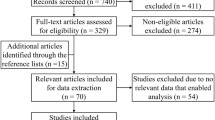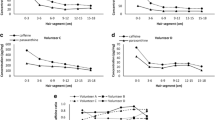Abstract
Purpose
This study investigated the effect of 1 g genistein daily for 14 days on caffeine-based metrics of cytochrome P4501A2 (CYP1A2), cytochrome P4502A6 (CYP2A6), N-acetyltransferase 2 (NAT2), and xanthine oxidase (XO).
Methods
A single dose of 100 mg caffeine was administered once before and once on the last day of a 14-day treatment regime with 1 g genistein once daily to 18 healthy female volunteers. Urine and blood samples were collected up to 12 and 24 h, respectively, after each caffeine dose. Using high-performance liquid chromatography (HPLC), caffeine and 1,7-dimethylxanthine (17X) were quantified in plasma, whereas 17X, 1,7-dimethylurate (17U), 1-methylxanthine (1X), 1-methylurate (1U), and 5-acetylamino-6-formylamine-3-methyluracil (AFMU) were quantified in urine. Urinary metabolite ratios were calculated to assess enzyme activities and compared between administrations using analysis of variance (ANOVA).
Results
Genistein decreased the urinary caffeine metabolite ratio used to assess CYP1A2 activity by 41% [90% confidence interval (CI) 28–51%). The urinary ratio indicating XO activity decreased by 29% (90% CI 24–32%), whereas urinary ratio for CYP2A6 activity increased by 47% (90% CI 29–66%) after 2 weeks of genistein. The NAT2 urinary caffeine metabolite ratio did not change significantly.
Conclusions
Two weeks of intake of 1 g genistein daily led to decreases in CYP1A2 and XO activity and an increase in CYP2A6 activity, whereas NAT2 activity did not change in healthy Chinese female volunteers. Pharmacokinetics of other substrates of the enzymes investigated here may be influenced in a similar manner.




Similar content being viewed by others
Abbreviations
- CYP450:
-
CYP450 monooxygenase system
- CYP1A2:
-
cytochrome P4501A2
- CYP2A6:
-
cytochrome P4502A6
- NAT2:
-
N-acetyltransferase 2
- XO:
-
xanthine oxidase
- 17X:
-
1,7-dimethylxanthine
- 17U:
-
1,7-dimethylurate
- 1X:
-
1-methylxanthine
- 1U:
-
1-methylurate
- AFMU:
-
5-acetylamino-6-formylamino-3-methyluracil
- UCMR:
-
urinary caffeine metabolite ratio
References
Liu ZH, Kanjo Y, Mizutani S (2010) A review of phytoestrogens: their occurrence and fate in the environment. Water Res 44:567–577
Villa P, Costantini B, Suriano R et al (2009) The differential effect of the phytoestrogen genistein on cardiovascular risk factors in postmenopausal women: relationship with the metabolic status. J Clin Endocrinol Metab 94:552–558
Scott LM, Durant P, Leone-Kabler S et al (2008) Effects of prior oral contraceptive use and soy isoflavonoids on estrogen-metabolizing cytochrome P450 enzymes. J Steroid Biochem Mol Biol 112:179–185
Shon YH, Park SD, Nam KS (2006) Effective chemopreventive activity of genistein against human breast cancer cells. J Biochem Mol Biol 39:448–451
Helsby NA, Chipman JK, Gescher A et al (1998) Inhibition of mouse and human CYP 1A- and 2E1-dependent substrate metabolism by the isoflavonoids genistein and equol. Food Chem Toxicol 36:375–382
Li X, Choi JS (2007) Effect of genistein on the pharmacokinetics of paclitaxel administered orally or intravenously in rats. Int J Pharm 337:188–193
Myers MG (1991) Caffeine and cardiac arrhythmias. Ann Intern Med 114:147–150
Cornelis MC, El-Sohemy A (2007) Coffee, caffeine, and coronary heart disease. Curr Opin Clin Nutr Metab Care 10:745–751
Tworoger SS, Gertig DM, Gates MA et al (2008) Caffeine, alcohol, smoking, and the risk of incident epithelial ovarian cancer. Cancer 112:1169–1177
Caubet MS, Elbast W, Dubuc MC et al (2002) Analysis of urinary caffeine metabolites by HPLC-DAD: the use of metabolic ratios to assess CYP1A2 enzyme activity. J Pharm Biomed Anal 27:261–270
Rostami-Hodjegan A, Nurminen S, Jackson PR et al (1996) Caffeine urinary metabolite ratios as markers of enzyme activity: a theoretical assessment. Pharmacogenetics 6:121–149
Tang BK, Zhou Y, Kadar D et al (1994) Caffeine as a probe for CYP1A2 activity: potential influence of renal factors on urinary phenotypic trait measurements. Pharmacogenetics 4:117–124
Tang BK, Kadar D, Qian L et al (1991) Caffeine as a metabolic probe: validation of its use for acetylator phenotyping. Clin Pharmacol Ther 49:648–657
Kalow W, Tang BK (1991) Use of caffeine metabolite ratios to explore CYP1A2 and xanthine oxidase activities. Clin Pharmacol Ther 50:508–519
Wong P, Villeneuve G, Tessier V et al (2002) Stability of 5-acetamido-6-formylamino-3-methyluracil in buffers and urine. J Pharmaceut Biomed 28:693–700
Grant DM, Tang BK, Kalow W (1983) Variability in caffeine metabolism. Clin Pharmacol Ther 33:591–602
Butler MA, Lang NP, Young JF et al (1992) Determination of CYP1A2 and NAT2 phenotypes in human populations by analysis of caffeine urinary metabolites. Pharmacogenetics 2:116–127
Tassaneeyakul W, Birkett DJ, Veronese ME et al (1993) Specificity of substrate and inhibitor probes for human cytochromes P450 1A1 and 1A2. J Pharmacol Exp Ther 265:401–407
Messina ES, Tyndale RF, Sellers EM (1997) A major role for CYP2A6 in nicotine C-oxidation by human liver microsomes. J Pharmacol Exp Ther 282:1608–1614
Nunoya KI, Yokoi T, Kimura K et al (1999) A new CYP2A6 gene deletion responsible for the in vivo polymorphic metabolism of (+)-cis-3, 5-dimethyl-2-(3-pyridyl)thiazolidin-4-one hydrochloride in humans. J Pharmacol Exp Ther 289:437–442
Nowell S, Sweeney C, Hammons G et al (2002) CYP2A6 activity determined by caffeine phenotyping: association with colorectal cancer risk. Cancer Epidemiol Biomarkers Prev 11:377–383
Hsieh JF, Wu SH, Yang YL et al (2007) The screening and characterization of 6-aminopurine-based xanthine oxidase inhibitors. Bioorg Med Chem 15:3450–3456
Fatokun AA, Stone TW, Smith RA (2007) Hydrogen peroxide mediates damage by xanthine and xanthine oxidase in cerebellar granule neuronal cultures. Neurosci Lett 416:34–38
Author information
Authors and Affiliations
Corresponding author
Additional information
This work was supported by the National Scientific Foundation of China (grant # 30801421) Huge Project to Boost Chinese Drug Development (grant # 2009ZX09501-032), 863 Projects (No. 2009AA022710, 2009AA022703, 2009AA022704) Fund by State Key Laboratory of Drug Research (grant # SIMM0812KF-01) and Research Fund for the Young Teachers Boost Plans of Chinese Central College (grant #201012200047).
Rights and permissions
About this article
Cite this article
Chen, Y., Xiao, CQ., He, YJ. et al. Genistein alters caffeine exposure in healthy female volunteers. Eur J Clin Pharmacol 67, 347–353 (2011). https://doi.org/10.1007/s00228-010-0964-5
Received:
Accepted:
Published:
Issue Date:
DOI: https://doi.org/10.1007/s00228-010-0964-5




